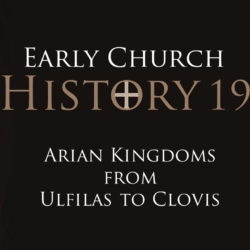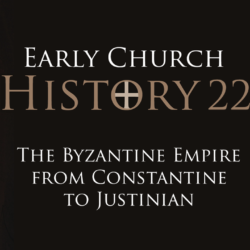This is part 20 of the Early Church History class.
So far we’ve been focusing primarily on Christianity within the Roman Empire in Europe, North Africa, and the Middle East–the land surrounding the Mediterranean Sea. Nevertheless, Christianity also spread south to Africa, north to Armenia, and east to Asia where it reached Persia, India, and China. Hopefully this session will counterbalance the Mediterranean focus we’ve had so far, expanding your perspective to be a little more global.
Listen to this episode on Spotify or Apple Podcasts
—— Links ——
- See my lecture on YouTube: History of Christianity in Africa
- For more on Armenian Christianity, see The Key of Truth: A Monument of Armenian Unitarianism
- More Restitutio resources on Christian history
- See other classes here
- Support Restitutio by donating here
- Join our Restitutio Facebook Group and follow Sean Finnegan on Twitter @RestitutioSF
- Leave a voice message via SpeakPipe with questions or comments and we may play them out on the air
- Intro music: Good Vibes by MBB Attribution-ShareAlike 3.0 Unported (CC BY-SA 3.0) Free Download / Stream: Music promoted by Audio Library.
- Who is Sean Finnegan? Read his bio here
—— Notes ——
Africa
First Century
- Jesus took refuge in Africa as a baby (Matthew 2:13-15)
- An African from Cyrene carried Jesus’ cross (Mark 15:21).
- At Pentecost, Jews from Egypt and Libya were present (Acts 2:10).
- At Antioch, Simeon called Niger and Lucius of Cyrene were part of the Jew-Gentile mixed church (Acts 13:1).
- Egypt
- By the 2nd c., New Testament scriptures were translated into Coptic.
- Alexandria was a center for Christianity (Clement, Origen, Arius, Alexander, Athanasius).
- Maghreb (North Africa)
- Christianity attested from at least the second century through martyrs of Scilla in Numidia and Perpetua and Felicitas in Carthage.
- Tertullian, Cyprian, Novatian, Donatus, and Augustine
- Ethiopia
- Frumentius and Edesius became slaves to the King of Axum.
- Athanasius of Alexandria ordained Frumentius a bishop.
- King Ezana became a Christian between 330 and 350.
- In the late 5th c., the nine saints came and founded monasteries, including at Debre Damo.
- In the 6th c., King Kaleb crossed the Red Sea to defeat Du Nawas, king of Himyar (Yemen). He then rebuilt the churches there and spread Christianity in the region.
- Nubia
- In the second half of the 6th c., Christian missionaries began converting key people in Makuria.
- Makuria became a mighty kingdom that held off the Muslims in the 7th c.
Armenia
- Christianity spread to Armenia from the south (Syria) and west (Constantinople).
- Gregory the Illuminator (Grigor Lusavorich) preached Christianity, but ran afoul of King Tiridates III (r. 298-330) who imprisoned him.
- Gregory converted Tiridates who declared Armenia a Christian Nation (c. 301).
- Mashtots (d. 440) knew Armenian and Greek.
- Worked under Catholicos Sahak (r. 387-438) to create Armenian letters and translate scriptures into Armenian
- Eznik (380-455) was a disciple of Mashtots who represented Armenia at the Council of Ephesus (431).
- Eznik wrote Refutation of the Sects, which survives today.
Asia
- India
- Thomas the Apostle (50s)
- In 240, The Acts of Thomas claimed that the Apostle Thomas travelled to India during the reign of King Gundaphar (first century).
- Ephrem the Syrian and Jerome mention Thomas in India, though Origen and Eusebius put Thomas in Parthia.
- Thomas the Apostle (50s)
- Local tradition in southwest India claims Thomas came there, and they call themselves “Thomas Christians” to this day.
- Travel was available between the Roman Empire and India.
- Samuel Moffett: “ [M]ost opinions range from ‘possible’ to ‘probable,’ with a discernible trend toward the latter position.”[1]
- Pantaenus (180 or 190)
- Eusebius and Jerome claim Pantaenus went to India on a trip
- Pantaenus’ disciples, Clement and Origen, seem to have a good knowledge of India.
- David of Bassora (300) preached in India.
- Bishop Theophilus the Indian (d. 364)
- Traveled to India on behalf of Emperor Constantius and found Christians in India
- He said they were different in some customs, but they agreed with him that the Son was “other in substance” than the Father.
- Cosmas the Indian Voyager (Indicopleustes)
- Reports about Christians on Taprobane Island (Sri Lnaka) in the 6th c.
- Persia
- Also called the Nestorian Church after Nestorius, bishop of Constantinople (r. 428-431)
- Jewish pilgrims from Parthia were at Pentecost in Jerusalem (Acts 2:9).
- Syrian Christians from Edessa spread to Persia.
- 340s Sassanian King Shapur II persecuted Christians, martyring 16,000.
- 410 Council of Seleuci-Ctesiphon (aka Council of Mar Isaac) King Yazdegerd I (r. 399-421) organized Christians in the Sassanian Empire and officially showed toleration, though Zoroastrianism remained the official state religion.
- 424 Church of the East declared independence from the Church of the Roman Empire.
- China
- Christianity is clearly attested starting in 635 when Alopen, the Nestorian missionary, came.
- It is likely that the Chinese came in contact with Christians from the nomads who lived on the other side of the Great Wall of China at the end of 6th c.
Review
- Christianity spread to Africa from the first century in Egypt, the Maghreb, and Ethiopia.
- King Ezana of the Axumite Empire became a Christian due to evangelism of Frumentius in the 330s.
- Athanasius of Alexandria ordained Frumentius Bishop and ensured that homoousion Christianity would take root.
- Christianity spread throughout Axumite Empire in the fifth century through the work of the nine saints who built monasteries, including the one at Debre Damo.
- In the sixth century, King Kaleb defeated the King of Himyar (Yemen) at the behest of the Roman Emperor to protect Christians and rebuild their churches.
- Armenia became Christian through missionaries from Syria in the south and from Constantinople in the west.
- Grigor Lusavorich (Gregory the Illuminator) converted King Tiridates III, who then sponsored the conversion of Armenia in 314.
- In the fifth century, Mashtots worked with a team to invent the Armenian alphabet and translate the Bible and many other Christian documents into Armenian.
- Although certainty is not possible, it is probably that the Apostle Thomas brought Christianity to India in the first century and Pantaenus visited in the second century.
- Bishop Theophilus, the Indian, visited India in the 350s and reported the Christians there were subordinationists who believed the Son was “other in substance.”
- Persia had Christians from the first century, first from Jewish pilgrims who attended Pentecost, then through Syrian evangelistic efforts centered in Edessa.
- Christians living under the Sassanian rule of King Shapor faced brutal persecution, torture, and martyrdom in the 340s.
- The Council at Seleucia-Ctesiphon of 410 ended the persecution and gave structure to Christianity within the empire, though Zoroastrianism remained the official state religion.
- In 424, Persian Christianity declared itself independent of Roman Christianity.
In the sixth century, nomads beyond the Great Wall of China likely brought Christianity in contact with the Chinese.
[1] Samuel Hugh Moffett, A History Christianity in Asia, vol 1 (Maryknoll, NY: Orbis Books, 1992), 35.






